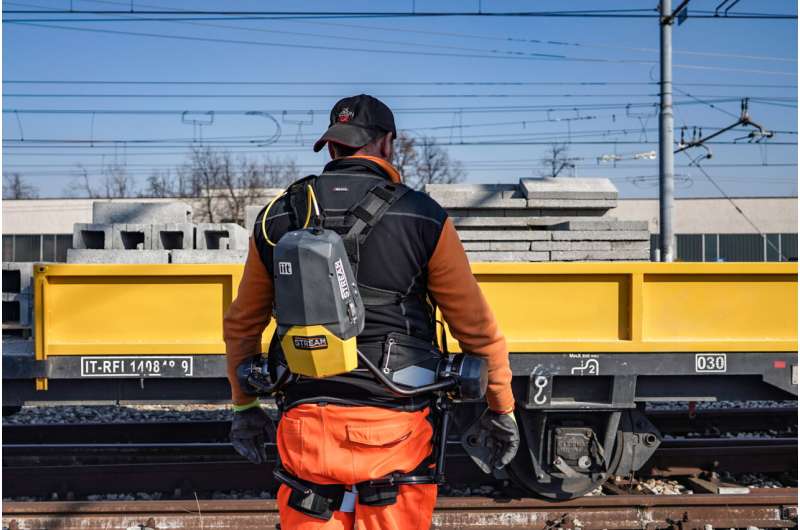A back support exoskeleton has been developed at the Istituto Italiano di Tecnologia (Italian Institute of Technology—IIT) to improve railway workers’ safety and conditions for heavy manual material handling during maintenance and renewal operations.
The prototype, named StreamEXO, was validated in approximately 100 hours of use by 15 people during a 6-month test campaign hosted in Italy highlighting a 50% reduction in the ergonomic risk of physical overload and a 30% of muscle fatigue. The exoskeleton was recently presented during a live demonstration with workers wearing StreamEXOs at the port of Tarragona, in Spain, and it is ready to start an industrialization process.
The exoskeleton StreamEXO has been developed within the European project STREAM coordinated by Christian Di Natali, researcher of the IIT—the first major strategic transnational initiative aimed at promoting research and innovation in the railway sector to make it more competitive, efficient and sustainable.
The STREAM project has introduced a new technological solution from Industry 5.0, where workers’ activities are connected, through the IoT, to wearable technologies and enhanced occupational exoskeletons. STREAM developed the exoskeleton StreamEXO and a fully automated excavator for accomplishing tasks in the rail worksites, such as ballast and sleepers’ replacement.
On June 8, researchers showed the exoskeleton and the automatic excavator in a rail worksite while simulating the project’s target activities at the STREAM’s final event in Tarragona, Spain. The event, hosted at Port of Tarragona, was attended by the Shift2Rail Project Office and the port’s authorities.
The STREAM exoskeleton (StreamEXO) generates forces which are distributed to the shoulders and legs to support the worker’s back during handling activities, such as lifting and carrying heavy loads. The device’s ergonomics have been studied to enhance comfort and provide totally free movements, ensuring a perfect fit on the worker’s body while carrying out dynamic activities.
The system has an innovative one-size-fits-all solution that guarantees both robustness and power, and a lightweight design (7 kg of weight with a battery of 6 hours autonomy).
The device comprises of a mechanical structure, some electric actuators, and an electronics system, completed by specific algorithms that assist workers during work tasks to reduce the risk of injury. Therefore, thanks to the control algorithms, the exoskeleton can interpret the movements that a person does to manage the different intensities of work and can automatically implement assistance strategies. Workers can use StreamEXO in a versatile way, also while they are driving vehicles or walking on rough terrain.
The benefits of the exoskeleton have been evaluated during an experimental campaign of six months hosted in railway construction sites by RFI and MERMEC STE s.p.a, including a final phase near Milan. The campaign saw several laboratory tests and an on-site validation with railway workers.
The final demonstration involved 15 workers for about 100 hours of use during real work activities in railways sites. They wore StreamEXO for carrying and positioning concrete conduit whose weight was between 20kg and 30kg.
Results showed a 50% reduction in the musculoskeletal system’s ergonomic risk of physical overload, particularly for the lumbar region. Fatigue was reduced by up to 30%, and muscle activity was also reduced by 25%.
The experimental campaign was fundamental to obtaining an advanced technological maturity level for the prototype, which is ready for future industrialization. The design of the StreamEXO created by IIT was intended to be a comfortable solution to be used during work shifts for workers employed in the heavy-duty industry and in the construction sector, such as railways.

